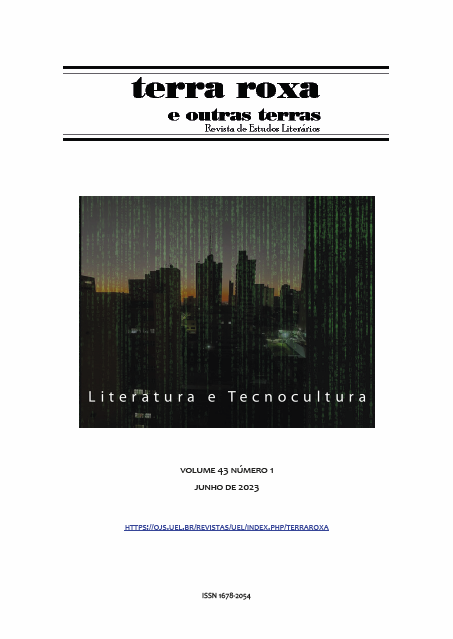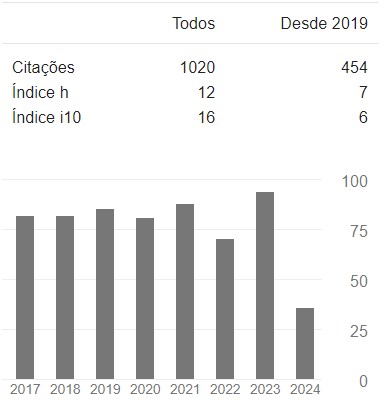As mídias como extensões do corpo: duplos, próteses e descorporificação em Consumidos, de David Cronenberg
DOI:
https://doi.org/10.5433/1678-2054.2023vol43n1p10Palabras clave:
David Cronenberg, Consumidos, Mídias como extensõesResumen
Publicado em 2014, Consumidos é o primeiro romance do cineasta canadense David Cronenberg. Ao longo de sua obra, em filmes como The Fly, Videodrome, Crash e eXistenZ, são constantes as sexualidades desviantes, o body-horror, o questionamento sobre o que é o real e sobretudo a relação entre orgânico e maquínico, entre corpo e mídia, ou melhor, ele atualiza a teoria mcluhiana de que as mídias são extensões do homem. No romance, Cronenberg retoma esse repertório temático ao narrar a história de um casal de fotojornalistas viciado em tecnologia que investiga um crime envolvendo um filósofo canibal e um médico que realiza procedimentos estéticos clandestinos. Gadgets, DSTs, réplicas em 3D, apotemnofilia, consumismo e canibalismo são alguns dos ingredientes dessa história que se passa num mundo dominado pelas imagens técnicas. Nesse sentido, o objetivo deste artigo é analisar Consumidos à luz dos Estudos da Mídia, tendo como aportes teóricos Marshall McLuhan, Friedrich Kittler, Erick Felinto e Donna Haraway.
Descargas
Citas
AYERS, Drew. Spectacular Posthumanism: the digital vernacular of visual effects. New York: Bloomsbury, 2019. DOI: https://doi.org/10.5040/9781501340116
BAZIN, André. Ontologia da imagem fotográfica. O que é o cinema?. São Paulo: Cosac Naify, 2014. 27-34.
BREDER, Debora. David Cronenberg: a “inquietante estranheza”. ALCEU, vol. 11, n. 22, p. 174-193, jan./jun. 2011.
BROWNING, Mark. David Cronenberg: author or film-maker? Bristol: Intellect, 2007.
CRONENBERG, David. Consumidos. Rio de Janeiro: Objetiva, 2014.
FELINTO, Erick. A imagem espectral: comunicação, cinema e fantasmagoria tecnológica. Cotia: Ateliê, 2008.
FLUSSER, Vilém. Filosofia da caixa preta: ensaios para uma futura filosofia da fotografia. Rio de Janeiro: Relume Dumará, 2009.
HARAWAY, Donna. Manifesto ciborgue: ciência, tecnologia e feminismo-socialista no final do século XX. Tomaz Tadeu, org. Antropologia do ciborgue: as vertigens do pós-humano. 2 ed. Belo Horizonte: Autêntica, 2009. 35-118.
KAUFFMAN, Linda S. Bad girls and sick boys: fantasies in contemporary art and culture. Los Angeles: U of California P, 1998. DOI: https://doi.org/10.1525/9780520919716
KITTLER, Friedrich. Gramofone, filme, typewriter. Belo Horizonte: Editora UFMG, 2019.
McLUHAN, Marshall. Os meios de comunicação como extensões do homem. São Paulo: Cultrix, 1969.
MONEY, John, Russell Jobaris & Gregg Furth. Apotemnophilia: two cases of self-demand amputation as a paraphilia. The Journal of Sex Research, vol. 13, n. 2, p. 115-125, maio 1977. DOI: https://doi.org/10.1080/00224497709550967
PRECIADO, Beatriz. Manifesto contrassexual: práticas subversivas de identidade sexual. São Paulo: n-1 edições, 2014.
ROSSET, Clément. O real e seu duplo: ensaio sobre a ilusão. 2 ed. Rio de Janeiro: José Olympio, 2008.
SONTAG, Susan. Sobre a fotografia. São Paulo: Companhia das Letras, 2004.
VIEIRA, João Luiz & Luiz Antônio L. Coelho. Subjetividade virtual em “nova carne”: o fim do tempo, espaço e corpo orgânico no sujeito recriado. Tadeu Capitastrano, org. O cinema em carne viva: David Cronenberg. Rio de Janeiro: WSET Editora, 2011. 93-98.
Descargas
Publicado
Cómo citar
Número
Sección
Licencia
Derechos de autor 2023 Gustavo Ramos de Souza

Esta obra está bajo una licencia internacional Creative Commons Atribución 4.0.
Los autores que publican en esta revista aceptan los siguientes términos:
a) Los autores conservan los derechos de autor y otorgan a la revista el derecho de primera publicación, siendo la obra licenciada simultáneamente bajo la Licencia Creative Commons Reconocimiento-No Comercial 4.0 Internacional, permitiendo la compartición de la obra con reconocimiento de la autoría de la obra y publicación inicial en este periódico académico.
b) Los autores están autorizados a asumir contratos adicionales por separado, para distribución no exclusiva de la versión del trabajo publicado en esta revista (por ejemplo, publicar en un repositorio institucional o como capítulo de libro), con reconocimiento de autoría y publicación inicial en esta revista. diario.
c) Se permite y anima a los autores a publicar y distribuir su trabajo en línea (por ejemplo, en repositorios institucionales o en su página personal) después del proceso editorial, ya que esto puede generar cambios productivos, así como aumentar el impacto y la citación del trabajo publicado (Ver Efecto del Acceso Abierto).
d) Los autores de los trabajos aprobados autorizan a la revista para que, luego de la publicación, transfiera su contenido para su reproducción en indexadores de contenido, bibliotecas virtuales y similares.
e) Los autores asumen que los textos sometidos a publicación son de su creación original, asumiendo total responsabilidad por su contenido en caso de objeción por parte de terceros.






















